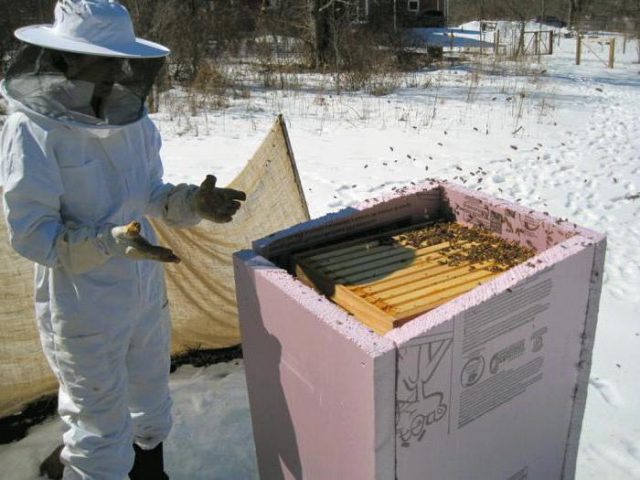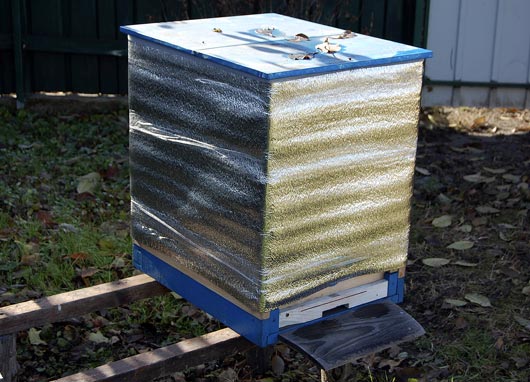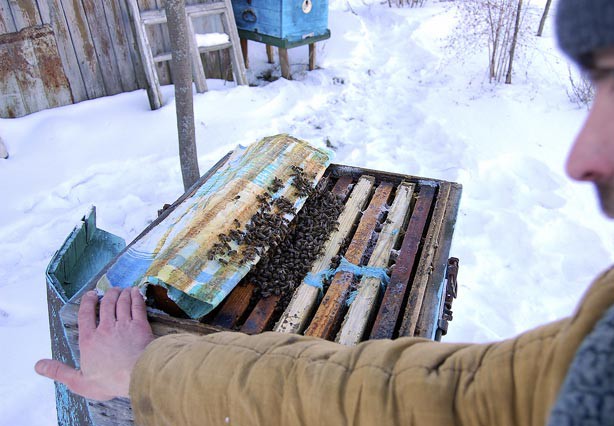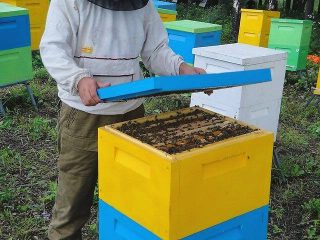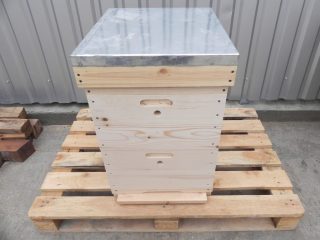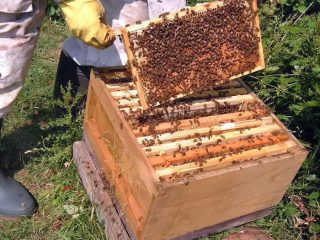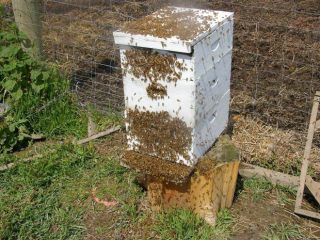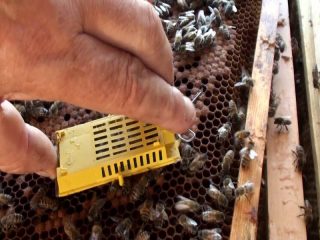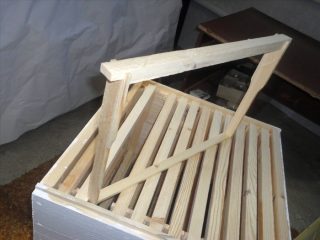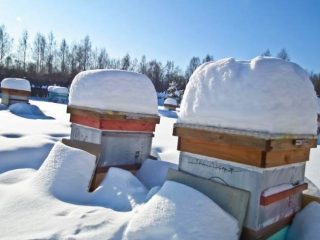Content
- 1 How bees winter in nature
- 2 Advantages and disadvantages of wintering bees outside
- 3 How to keep bees outside in winter
- 4 How to prepare bees for wintering outdoors
- 5 How and when to insulate families during the wintering of bees in the wild
- 6 Wintering of bees without insulation in the wild
- 7 Wintering of bees outside in housings
- 8 Features of wintering bees in the wild in Siberia
- 9 How to prepare bees for wintering on the street in the Moscow region
- 10 The death of bees in winter: causes and possibilities of their elimination
- 11 Inspection of hives in winter
- 12 Conclusion
In winter, bees gain strength and prepare for active spring work. If earlier beekeepers tried to remove the hive for the whole winter indoors, recently they began to practice wintering bees in the wild. Subject to certain rules, it is possible to provide the most comfortable conditions for insects. For this purpose, special attention is paid to preparatory measures.
How bees winter in nature
The active work of insects occurs in the warm season. In winter, bees gather in a heap, warming each other. This allows them to cope with the cold without any problems. At the apiary, the beekeeper takes care of preparing the hive for wintering. In nature, bee colonies most often hibernate in the hollow of a tree. They store and feed on nectar throughout the winter.
Wild bees do not leave their hive during the winter, as they cannot withstand the effects of low temperatures. At the end of autumn, the metabolism of insects gradually slows down. The need to empty the bowels completely disappears. This allows you to be in the hollow for a long time without flying out into the street.
Advantages and disadvantages of wintering bees outside
Before choosing a method of placing bees, you need to familiarize yourself with the advantages and disadvantages of wintering outdoors. The pluses include:
- bees return to work ahead of schedule;
- the strength and strength of the bee family increase;
- saving for the beekeeper in time and money in the absence of the need to build a winter house.
The disadvantages of wintering on the street include increased feed intake. In this case, it is required to make significant reserves. If insects have any problems during wintering on the street, the beekeeper will not be able to help them. For this reason, the risk of death of the family increases.
How to keep bees outside in winter
In order for the bees to winter comfortably on the street, they should be provided with the necessary conditions. Initially, preparatory work is carried out. These include insulating the hive, providing the bees with food and ventilation. An important step is the preparation of feed. The energy of the bees depends on its quantity and quality. Lack of energy leads to insufficient heat production, which provokes hypothermia and further death.
How to prepare bees for wintering outdoors
Preparing bee colonies for wintering in the wild means strengthening the health of existing individuals and raising young ones. At the beginning of autumn, the hive is treated with a solution from ticks. You should also prepare sugar syrup in advance. To prepare it you will need:
- 2 kg of sugar;
- 1 liter of hot water;
- 1 tsp acetic acid.
Cooking process:
- The components are thoroughly mixed and put on fire.
- The syrup should be boiled no more than 15 minutes after boiling.
- After removing from the heat, the top dressing is removed to the side so that it cools down.
For wintering, it is better to place the hive in a quieter place. It is also necessary to assess the condition of the hive. If the family is strong enough, about 8-10 frames are left in it. Old damaged structures are removed or replaced with new ones.If the colony is weak, then it is united with another group of bees.
How and when to insulate families during the wintering of bees in the wild
Preparing bees for winter outdoors includes the process of warming the hive. With a strong draft, the bees die. But this does not mean that you need to carefully plug all openings in the home. In this case, insects will suffer from lack of air. Therefore, it is important to ensure proper ventilation during the wintering of bees outside. For this, the upper entrances are slightly opened. To insulate a bee house, it is recommended to use one of the following materials:
- polyurethane foam;
- plywood;
- straw;
- unnecessary clothing;
- polyethylene;
- expanded clay;
- Styrofoam.
A bee nest is placed near trees and bushes. They help close the hive from cold winds. From the inside, the hive is insulated by the outpost frame. From the outside, the insulation is fixed in any way possible. It is important that the hive is at a sufficient height from the ground. This will provide protection against rodent attacks and freezing of the soil. With the onset of a snowy winter, snow walls are built around the hive to warm the hive.
Wintering of bees without insulation in the wild
Hibernation of bees in the wild under the snow is considered the easiest. First, the hive is covered with some kind of material that prevents snow from entering during the melting process. The next step is to cover the bee dwelling with abundant snow. The advantage of such wintering is the early activation of insects, immediately after the thaw. The disadvantages include the impossibility of using this method in regions with snowless winters. The snow covers the bee dwelling from the cold winds. But if it melts prematurely, there is a possibility of flooding the hive.
Wintering of bees outside in housings
The housings are constructions for the wintering of bees, consisting of the roof of the wall-shields. The walls are made of untreated boards and slabs, the thickness of which varies from 20 to 25 cm. Small gaps are left between the boards. They provide oxygen to the hives.
The bee colony is put in housings in early November. In the apiary, props filled with dry leaves are placed. The hives are placed on lining in 2 rows. At the same time, the holes are located from the outside. Layers of slate are placed on top. With the help of snow, they form a wall and fill the roof with it. The ventilation holes remain intact. The advantages of wintering outdoors in jackets include:
- good ventilation;
- smoothing temperature fluctuations.
Features of wintering bees in the wild in Siberia
The preparation of bees for wintering in the wild in Siberia has no pronounced differences. It is believed that when located outdoors, bees tolerate low temperatures more easily than stuffiness and lack of air. The most common way to insulate a hive in this region is under the snow. The most important thing is to protect the hive from cold winds. For successful wintering, it is enough to carefully insulate the bee dwelling and cover it with snow. Since the snow in Siberia does not melt throughout the winter, there is no need to constantly monitor the condition of the bees.
How to prepare bees for wintering on the street in the Moscow region
In the suburbs of Moscow, bees endure wintering outdoors without any problems. Due to unstable weather, you should not rely on snow insulation. It is necessary to thoroughly insulate the bee dwelling and prevent dangerous diseases.
The peculiarities of the climate of the Moscow region include a high probability of mold formation on the walls of the hive. To prevent this from occurring, you should increase the space under the frame. This will allow air to enter the hive in the right amount.
The death of bees in winter: causes and possibilities of their elimination
During wintering on the street, the probability of death of bees increases. Initially weakened families are in the high-risk category. In some cases, external factors have a depressing effect on bees.The family can also be destroyed from the inside under the influence of fungi, mites or infections. To avoid massive death of insects, you should properly prepare them for wintering. Possible reasons for the sickness of bees include:
- poor ventilation;
- diseases;
- rodent attacks;
- poor choice of the location of the hive;
- a sharp change in climatic conditions;
- lack of feed.
The best way to deal with the death of bees is to properly prepare their home for wintering outdoors. For each hive, you need to leave at least 25 kg of honey. The main criterion for choosing nectar is its quality. It is equally important to sanitize the hive against varroatosis, nosematosis and acarapidosis. It is equally important to patch all holes, which will exclude the possibility of rodents entering the hive.
The most common diseases characteristic of the winter period are nosematosis. The reasons for its occurrence are:
- the presence of honeydew in honey;
- getting into the hive of pesticides;
- sharp temperature fluctuations.
If the process of death has already begun, it is almost impossible to save insects. The likelihood that the beekeeper detects the problem in time is too low. In this case, the bees are taken from the street to the winter house and their dwelling is completely rebuilt. If the queen dies, the family is united with another swarm, more powerful. In order for the family to accept new bees, the process of resettling is carried out with extreme caution.
Inspection of hives in winter
If the beekeeper has already taken care of creating favorable conditions for the wintering of bees outside, frequent checks of the hive are not required. In this case, it is advisable to control the temperature in the bee house 2 times a month. You should also monitor the intake of air by monitoring the position of the ventilation holes. At the end of winter, it is necessary to increase the frequency of visits to 1 time per week.
The state of insects can be judged by the sounds coming from the hive. To do this, you need to gently hit the surface of the hive. The fading buzzing indicates a prosperous state of affairs in the dwelling. If the noise continues, then the uterus is dead. If you hear a slight rustle, it is a lack of feed.
It is important to pay attention to the pore in the hive. If there are individuals with gnawed wings next to it, rodents periodically visit the hive. Swollen abdomens in insects indicate the spread of the disease. Increased noise may indicate dry indoor air. Placing a water bottle behind an insert board will help solve this problem. A wick made of cotton material is dipped into it. The other end of the wick is placed over the tuber so that the bees have access to water.
If the harvested feed for the winter was not enough, it is necessary to feed with honey. The frame with it is placed in close proximity to the ball of bees. An alternative to honey can be a thick sugar syrup. It is poured into honeycombs, replacing it with new portions as it is consumed.
To avoid getting wax moths in the hive, freeze the honeycomb a little. In this case, it is enough to subject them to cooling at about -6 C °. This method is considered effective, regardless of the stage of development of the moth.
In the spring, it is necessary to free the hives from unnecessary fences and frames. It is necessary to create conditions for the first flight of bees outside. You should also clean the house from the dirt accumulated over the winter.
Conclusion
Hibernation of bees in the wild is a natural but risky process. Only strong families will be able to survive this period without loss. The task of the beekeeper is to insulate the hive and provide the required amount of food for the winter. If these conditions are met, the bees survive until spring without any problems.
